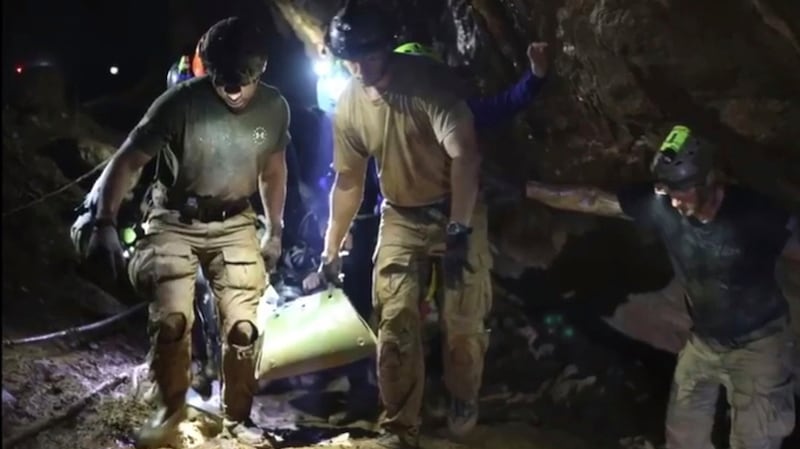Cave diver Jim Warny (35) has been in far more extreme subterranean conditions than Tham Luang in northern Thailand, where he was part of the team that rescued 12 young soccer players and their coach last week.
The Burren and Slieve Aughty lowlands, where the Belgian national has set new exploration records, are highly challenging, and he has been in far tighter situations in several parts of the world, most recently in Mexico.
However, he says what made the difference last week was “the psychological factor” and knowing the lives of boys only a few years older than his son, Ciarán (9), were at stake.
When Warny, who lives in Co Clare, became one of the lead divers in the last stages of the rescue, he was responsible for navigating the sedated soccer coach Ekapol Chantawong (25) to safety through much of the 4km cave system.
What made the entire rescue a “miracle”, in his view, was that no one person was in charge. The death of former Thai navy Seal diver Saman Kunan had convinced the Thai authorities that a purely military style approach would not work.
"And so although there were many difficulties, and we were all operating outside procedures, it all came together," Warny told The Irish Times. "It was one of the downfalls, but one of the successes, that because there was no one authority and no one person had the complete answer, it worked."
Passion
The Lufthansa electrician took up cave diving 20 years ago, and exploration became his passion after he moved to Ireland. One of his friends was Polish explorer Artur Kozlowski, and the two of them set a new Irish-British record for a 4km traverse of a water-filled system in the Gort lowlands in 2010.
When Kozlowski went missing during an attempted traverse of the Pollonora cave system near Kiltartan in 2011, Warny located his friend’s body at a depth of 52m. Two of the leading British cave rescuers, fireman Rick Stanton and IT consultant John Volanthen, worked with Warny on that operation.
“These were people I had looked up to and learned from, because cave exploration is something you have to be mentored in,” he says.
It was Volathen who found the 12 boys and their coach on a narrow ledge on July 2nd, and from then on Warny was waiting for a call. He flew out on July 6th.
Like mountaineers, cave divers have to manage risk, be self sufficient, but accept that in a subterranean environment there is little or no chance of rescue – only, as his late friend Kozlowski told this newspaper, “recovery if you are lucky”.
‘Compartmentalise your thoughts’
“You compartmentalise your thoughts, and you have to go in knowing you can answer every question,” Warny says.
It was difficult to focus en route to northern Thailand, with “so much information”, but once he was in situ he knew it was “within my comfort zone”.
In a highly claustrophobic, airless, dark and dank environment, panic attacks are a hazard that every cave diver has to train for
“At the same time, nothing could really prepare any one of us for this,which was something we had never experienced,” he says.
In a highly claustrophobic, airless, dark and dank environment, panic attacks are a hazard that every cave diver has to train for. It became clear that the only safe way to take the boys and their coach out was to sedate them, and transport them, sometimes submerged, on stretchers equipped with oxygen.
Fortunately Australian diver Dr Richard Harris, who was part of the international diving team, specialises in anaesthesiology.
Pushing, sliding
On his first day, Warny was a support diver as part of the chain, pushing, sliding, carrying the stretchers over a period of five and six hours at a time.

Whereas the first 1km of the cave system could be walked through, the latter recesses were “fairly tight”, he says.
“It was never so tight that we had to take our gas bottles off,” he says, adding that visibility was very poor and down to “touch” in some places.
On his third day down, he was one of the main divers charged with bringing the coach out for most of the route.
“ The coach had said he wanted to be the last to leave, but it was not his call, and so he was ninth out, and he was also sedated,” Warny says.
Tight finish
Rising water levels on that final day and a breakdown in pumps provided a tight finish, but those still inside the cave system at that point had diving gear, he says.
After a weekend at home in Clare, Warny was back at work on Tuesday. His partner, Asia, and father, Rene, welcomed him home at Shannon. His mother, Rita, who died last year, “would worry about me, but she trusted me in what I did”, he says.
Asked for his views on Elon Musk’s criticism of one caver on Twitter – after Musk’s offer of a submarine was turned down – Warny says the remarks were “uncalled for”.
“Vern Unsworth, the expatriate diver who knows the Tham Luang cave system, was really important in helping us,” he says.
Warny would love to return to Thailand, knows film rights are already being talked about and wouldn’t mind being involved.
“But it is back to normal now. I’ll probably go cave diving this weekend.”











